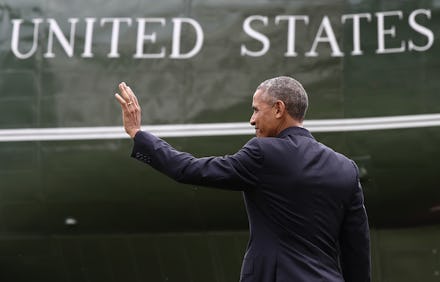What is the US deficit under Obama? Here are the latest figures.

A budget deficit is how much more money a government spends than it takes in on any given year. Big deficits can have benefits for countries, but over a longer term may lead to problems like slow economic growth.
President Barack Obama came into office during one of the nation's worst economic recessions and consequently increased spending to jumpstart the economy — his stimulus bill cost $800 billion, and the total deficit in 2009 was an unprecedented $1.4 trillion.
While the total deficit hit that historical high at the start of Obama's presidency, it has generally declined in the years since. The most recent deficit figure for the fiscal year ending Sept. 30 is $587 billion.
What does that mean in context?
Here's how the annual deficit has changed over the last eight years, according to government data:
2008: $459 billion
With two exceptions, including this past year, annual deficits generally fell during Obama's presidency.
One major reason for the increase in the deficit for 2016 relative to 2015 is lost revenue from recently extended tax cuts, according to the New York Times.
Obama entreated Congress at the beginning of 2016 to greenlight tax hikes for wealthy Americans and banks — to offset the tax breaks — to no avail.
As you can see in the chart below, inflation-adjusted (pegged to 2009 dollars), deficits under Obama also fell relative to U.S. gross domestic product — the total amount of money we make from goods and services. It's useful to measure deficits in terms of GDP for a truer "sense of scale" relative to the size of the economy.
Why does the deficit matter?
For one, failing to balance the budget year after year can saddle future generations with high national debt from the cumulative deficits.
Large deficits may also lead to inflationary pressures and could discourage buyers from purchasing government bonds — which can drive up the yields on those securities. And if those bonds are being used to finance the deficit, higher yields will make it even more costly to reduce the debt down the line.
Keeping the deficit low is also beneficial for the nation in the case of an economic crisis — because it means the government has more room to increase spending. After all, an economic crisis means more people are out of work, which means more people are collecting unemployment, among other costs to the government.
There is a big caveat, though: Dramatic deficit reduction can actually impede or stagnate economic growth, and may even precipitate a recession, as the world witnessed in the case of Greece.
How would the deficit change under Trump or Clinton?
A recent report by the Committee for a Responsible Federal Budget, a bipartisan think tank that promotes fiscal responsibility, found that the latest proposed policies from Republican presidential nominee Donald Trump and Democratic presidential nominee Hillary Clinton would increase the deficit by about $5.3 trillion and $200 billion, respectively, over the next 10 years.
That's a pretty big difference. As CNBC pointed out, Trump's tax plan increases the deficit 26 times more than Clinton's, enough so that the CRFB found it would total 105% of U.S. GDP.
Of course, Trump argues that the cost of his plans will be offset by huge growth. But even conservative think tanks who generally favor lower taxes, such as the Tax Foundation, have raised eyebrows at his estimates.